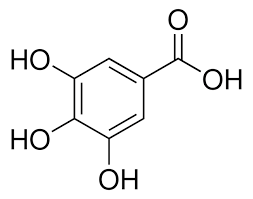Gallic Acid

Product Description
Gallic acid is a phenolic compound found in various plants, fruits, and beverages such as tea and wine. It has several industrial applications due to its antioxidant, antimicrobial, and anti-inflammatory properties.
Product:
Gallic Acid
CAS:
149-91-7
Synonym:
3,4,5-Trihydroxybenzoic acid; Benzoic acid, 3,4,5-trihydroxy-
Structure:

Typical Characteristics
Appearance
Colorless or slightly yellow solid
Boiling point
501 °C
Density
1.69 g/cm3
Flash Point
271 ºC
Melting point
210 °C
Molecular Weight
170.12
Odor
Odorless
Purity
≥98%
Refractive index
1.73
Uses, Applications & Markets
Key applications
get a quote



Gallic Acid used in many
industry applications
Gallic acid is a phenolic compound found in various plants, fruits, and beverages such as tea and wine. It has several industrial applications due to its antioxidant, antimicrobial, and anti-inflammatory properties. Some of its key industrial uses include:
- Pharmaceuticals: Gallic acid is utilized in pharmaceutical formulations as an antioxidant and preservative. It helps extend the shelf life of medicines and prevents oxidation-induced degradation of active pharmaceutical ingredients.
- Food and Beverage: In the food and beverage industry, gallic acid serves as a natural antioxidant and flavor enhancer. It is added to food products, beverages, and dietary supplements to prevent rancidity, improve stability, and enhance the sensory characteristics.
- Cosmetics: Gallic acid is incorporated into cosmetic formulations such as skincare products, hair care products, and anti-aging creams due to its antioxidant and anti-inflammatory properties. It helps protect the skin from oxidative stress, UV radiation, and environmental damage.
- Photography: Gallic acid is used in the development of photographic films and papers as a reducing agent and developer. It reacts with silver ions to produce silver particles, which form the visible image on photographic materials during the development process.
- Tanning: In the leather industry, gallic acid is employed as a tanning agent in the production of leather goods such as shoes, bags, and garments. It reacts with proteins in animal hides to form stable complexes, resulting in soft, durable, and water-resistant leather products.
- Research and Laboratory: Gallic acid is utilized in biochemical research, chromatography, and laboratory analysis as a reference standard, reagent, or analytical tool. It is employed in assays, tests, and experiments to study antioxidant activity, enzyme inhibition, and chemical reactions.